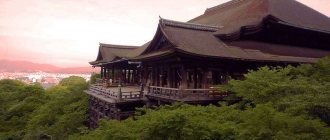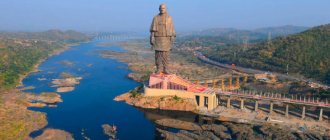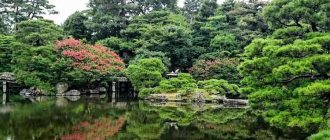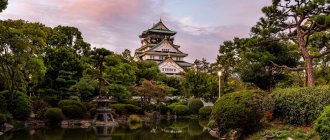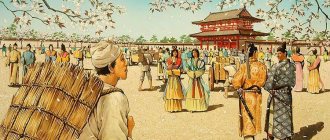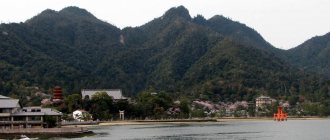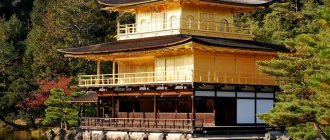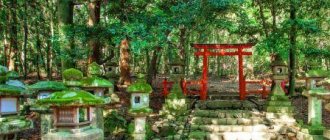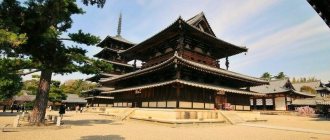Kiyomizu-dera Temple (Holy Water Temple) is a Buddhist complex in eastern Kyoto and is the most visited religious site in Japan. Every year, more than three million tourists from all over the world cross the sacred threshold. The full name of the temple - Otowasan Kiyomizudera - comes from the name of the spring located on Mount Otowa and forming a picturesque waterfall, the view of which opens from the terrace of Kiyomizu-dera. The terrace itself is of particular interest not only to tourists, but also to engineers. It rests on 100 wooden pillars and was built without a single nail.! And it has always been this way - from the very foundation in 778. In 1994, Kiyomizu-dera Temple was included in the UNESCO World Heritage List.
History of Kiyomizu-dera
There are many different legends surrounding the foundation of the temple. The most popular and generally accepted is the one that tells about the monk of the monastery Kojima-dera Entinu . In a dream, the Bodhisattva Thousand-Armed Kannon appeared to him and pointed to Mount Otowa as the site of the future temple, which Entin was to found. In the beginning it was a small, poor settlement of monks, but a meeting with the shogun Sakanoue no Tamuramaro completely changed the history of this place. Having healed the shogun's wife from a serious illness with the help of a prayer addressed to Kannon, Entin made the noble family the main patron of Kiyomizu-dera. In just a short period of time, the temple became known throughout the area. And already in 805, by order of Emperor Kammu, the monastery became the property of the Imperial House .
Over 1200 years of history, the Holy Water Temple was regularly burned and destroyed, but each time it was reborn. In the 17th century, during the reign of the Tokugawa shogun, Kiyomizu-dera received its current beauty. The best specialists of that time were involved in its construction.
On the eve of the 2021 Olympic Games, a complete restoration of all buildings of the temple complex was carried out. Kiyomizu-dera was significantly updated and was ready to set a record for the number of tourists visiting the monastery in a year. But the coronavirus epidemic prevented the plans from coming true.
My 100 roads
Kiyomizu-dera Temple is quite large, with more than 30 buildings preserved from 1633, so it takes a lot of time to examine everything well. Let's continue.
– View of Kyoto at night from Kiyomizu Temple
Part 3 – Kyoto – the soul of Japan
– Day fourteen – Kiyomizu-dera (Kiyomizu-dera) – 2
On the eastern side of the main building of the complex is the hall of Buddha Shakyamuni
or
Shakado (Shaka-Do / 釈迦堂) [13]
- a strict structure with walls of unpainted wood and white partitions under a cinnamon-colored cryptomerium roof.
the Shakado altar
, preserved from the Kamakura era, is very famous .
From the north to Shakado
adjacent is a small chapel with a statue of
Nishiki no Jizo (Nishimuki Jizo-Do / 西向地蔵堂) [14]
- Jizo, facing the West, where, according to Buddhist views, heaven is located.
Adjacent Amida Buddha Hall
–
Amidado (Amida-Do / 阿弥陀堂) [15]
– stores the statue of the merciful Buddha Amida and the statues of Nikko Bosatsu and Gekko Bosatsu - Buddha of sunlight and Buddha of moonlight.
– Amida Buddha Hall – Amidado (Amida-Do/阿弥陀堂)
According to legend, it was at this place on May 15, 1188 that the Buddhist monk Honen (法然), the founder of the Pure Land doctrine, announced the birth of a new doctrine, the basis of which was to be boundless faith in Amida Buddha. It was from here that the words “Namu Amida Butsu!” were first heard. (“Hail, Buddha Amida!”), in which many, many followers of Honen sought hope for salvation and subsequent rebirth in the Western Paradise.
During the Heian period, the teachings of the “pure land” school achieved popularity. It was first adopted by aristocrats, and later spread among the general population due to the simplicity of the teaching of salvation and rebirth in a “pure land” through prayer to Amida Buddha. Amida - Buddha of light. His arrival should lead his adherents to the pure lands - the paradise of Buddhas and bodhisattvas. Following her solar path, Amida relieves all who have achieved some degree of enlightenment from ignorance and fear. The palace nobility began to build private Buddhist temples on their estates in order to have a statue of Amida next to them and support religious meditation.
Sandwiched between the Amidado and Shakado halls is the tiny Hall of a Hundred Jizo
–
Hyakutai Jizo-Do (百体地蔵堂) [16]
, in which there is an altar with more than 200 small stone statues of the bodhisattva Jizo.
Jizo is the patron saint of travelers, pregnant women and children, so
those who for some reason have lost a child often come the Hall of One Hundred Jizo It is believed that among many sculptures you can definitely find one that looks like a lost child. (Again, we already saw this in Kamakura at Hasedera Temple, in the post about which I wrote in detail about this)
– Amida statue on the terrace of the Hidden Temple – Hidden Temple or Oku-no-in (Oku-no-In/奥の院), view from Kiyomizu no Butai
The main shrine of the Hidden Temple
or
Oku-no-in (Oku-no-In/奥の院) [17]
, erected in honor of the Thousand-Armed Kannon and her companions Bishamon and Jizo, is a stone statue of Kannon standing in the center of the hall in a water-filled font. According to popular belief, if a tear runs down the bodhisattva’s face during prayer, this is a sure sign that Kannon has shown her mercy to the sufferer and has completely cleansed his soul of filth.
Bishamon or Bishamonten is one of the seven Japanese gods who bring happiness and good fortune.
Seven gods of happiness
–
Bishamonten
(毘沙門天 - patron of wealth and warriors),
Benzaiten
(弁財天 - love, art, beauty),
Daikokuten
(大黒 - wealth and agriculture),
Hotei Osho
(布袋 - love, joy),
Fukurokuju
(福禄寿 - wisdom),
Jurojin
(寿老人 - longevity) and
Ebisu
(恵比寿 - happiness and luck)
Behind the Main Hall (Hon-Do/本堂)
there is a Shinto
idol Jishu
or
Jishu-jinja (Jishu-jinja / 地主神社) [18]
, dedicated to the deity of love
Okoninushi-no-Mikoto (Okuninushi-no Mikoto / 大国主命)
, or rather, among other things, he is the patron saint of marriage and family ties, and his messenger is the hare.
– Okoninushi-no Mikoto (大国主命) and the hare – “Stone of Love”
Somehow I didn’t come across a fairy tale about how Okoninushi-no-Mikoto
became a god, I only know briefly that the above-mentioned hero fought for the hand and heart of the daughter of
Susanoo
(I mentioned him when I wrote about Miyajima) and won. For which he became not only the ruler of the country of Izumo, but also the patron god of marriage and love.
This small shrine complex is about 400 years old, although the belief in a happy marriage is much older than the Kiyomizu Temple that sheltered it.
– Sanctuary Lanterns
– Girls in yukata kimonos write wishes in Jishu-jinja (Jishu-jinja/地主神社) – Stairs leading to the Jishu Shinto shrine
In front of the shrine are two stones lying a few meters from each other. Legend says that if you walk from one stone to another with your eyes closed, you will definitely meet your love soon. If someone helped you at the same time, this means that it will not be easy to find your soulmate without outside help.
Near this temple you can buy a rice paper angel figurine for 200 yen - Hitogata-barai (人形祓い)
, write your name, age and what particularly worries you, then lower it into the water, where the piece of paper will dissolve, and with it all your worries.
Temple visitors also buy o-mikuji
(fortune telling) and if they do not meet your expectations, they can be tied to special perches, from which they will then be removed and burned.
– The girl decided to tell fortunes for luck in love – At the end of the day they collect o-mikuji
All temples and sanctuaries sell happiness, luck, health, prosperity and love in the form of talismans, amulet and fortune telling. Such a simple and naive belief in the best. Or maybe that’s how it should be? People write their wishes on emo signs and hope that the spirits or gods will see and read them and fulfill them. As you noticed, I like to photograph such ema signs, but this one is simply a masterpiece. Someone played with the seal of the temple in a designer way, describing their desires in detail. I personally have no idea what is written here, but let the person be lucky.
– Wishes/wishes sign – Ema, in Jishu-jinja/地主神社
Just like that, four hours, if not more, flew by unnoticed. Then we waited until sunset to photograph the pagoda, and while waiting I watched the people.
– Girl in komon kimono – Girls in yukata kimono
– A novice monk collecting alms – Daughter and father in national clothes, kimono
As you can see, we were only in Kyoto for a few hours and didn’t specifically run anywhere to photograph the Japanese in national clothes. I just sat near the temple and took pictures of people passing by. If you read my report from the very beginning, you noticed that the Japanese wear a kimono quite often and a kimono serves them not only as a “dress for going out”, but also for every day. Even though it’s the beginning of October, many girls wear yukata, but this is still a summer kimono and a very popular one. You can buy it for yourself as a souvenir. I really want to buy a kimono of a higher rank, just for visits, but more on that later.
– Women in kimonos, evening in Kyoto
Now we go back to the hostel. We decided to take a walk and have dinner along the way. From the temple we walked along Kiyomizu-zaka (清水坂), then along Higashi-oji-dori (東大路通 or “Great Eastern Boulevard”), found a small cozy restaurant where we ate okonomyaki and met a young couple from the Far East. Like this! The spirit of the city of Kyoto was very kind to us today.
Maps and useful links
(jpg 139Kb) Map of Kyoto (pdf 7.7Mb) Map and short guide to Kyoto (pdf 2.5Mb) Kyoto bus map (pdf 6.8Mb)
More photos: Australian Photography by Ilya Genkin.
Information in the post may be added and changed! Subscribe to RSS
and don't miss the next articles.
To be continued.
Part 1 – South-West
Part 2 –
Tokyo and surroundings
Part 3 –
The Soul of Japan
– chapter 1 – Evening in Kyoto – Arrival – chapter 2 – Kiyomizu-dera – 1 – chapter 3 – Kiyomizu-dera – 2 – chapter 4 – Temples and Gardens – Golden Pavilion – Kinkaku-ji (金閣寺) – Chapter 5 – Temples and Gardens – Ryogen-in (龍源院) – Chapter 6 – Temples and Gardens – Korin-in (Korin-in/興臨院) and Ryoanji (龍安寺) – chapter 7 – Evening in Kyoto – Kyoto Tower (京都タワ) – chapter 8 – Fushimi Inari (伏見稲荷) – chapter 9 – Byodo-in Temple (平等院) – Temple of Equality – Chapter 10 – Tofuku-ji Temple (東福寺) – Eastern Treasure Temple – Chapter 11 – Yasaka Shrine (八坂神社) – Temple Eight Hills - Chapter 12 - Tenryu-ji Temple (天龍寺) - Heavenly Dragon Temple - Chapter 13 - Nanzenji Temple (南禅寺) and Aqueduct - Chapter 14 - Nishiki Market (錦市場) – chapter 15 – Arashiyama – chapter 16 – Nishijin-Ori Kaikan (Nishijin-Ori Kaikan/西陣織会館) – chapter 17 – Kimono Show (着物ショー) – chapter 18 – Imperial Palace in Kyoto (Kyoto Imperial Palace/Kyoto Gosho/京都御所) – chapter 19 – Hase-dera Temple (Hase-dera/長谷寺) in Nara (Nara) – chapter 20 – Evening in Kyoto – Kyoto Station (京都駅) – chapter 21 – Osaka – Osaka Castle (大坂城) – chapter 22 – Osaka – Shitennoji Temple (四天王寺) – Temple of the Four Heavenly Lords – chapter 23 – Evening in Osaka – Umeda High-Rise Complex Sky Building/Umeda Sky Building/梅田スカイビル) – Chapter 24 – Osaka – Aquarium Kaiyukan/海遊館
What to see
- Otowa Waterfall . There is a mandatory ritual - washing your hands and face in the waterfall. Otov has three streams, each with its own properties - love, longevity and success in life. You only need to take one sip from the stream of interest. If you take another sip from another stream, the magical effect from the first stream will be halved. The greedy people who drink from all the streams get nothing.
- Nio Gate . A large structure, 14 meters high and 10 meters wide. They got their name from the divine guardians of Buddha. In 1477 the gate was destroyed. A century later they were rebuilt. In 2003, a major renovation was carried out.
- Kiyomizu Terrace . It stands out for its huge area. The supports are wooden pillars 13 meters high. The main feature of the design is that no nails were used during the construction process. The terrace offers a simply gorgeous view of the city of Kyoto. The view from here is especially beautiful during the cherry blossom season.
LatLong.ru
Recalculation of geographical coordinates. Degrees -> degrees/minutes/seconds:
Recalculation of geographical coordinates. Degrees/minutes/seconds -> degrees: Determination of altitude above sea level by coordinates: A form for searching for geographic coordinates of an object based on Google or Yandex map services.
| Examples: | Moscow Novgorod region, Berdsk St. Petersburg, Dvortsovaya embankment, 38 55.7522,37.6156 (latitude, longitude) |
Recently searched:
N 56.6375° E 47.8915° (yandex) 59°57 'N, 30°19 'E (yandex) 55.719444 , 37.815556 (yandex) n 59.939 e 30.3158 (yandex) Latitude 56.0013 Longitude 92.8856 (y andex) Sphinx of Giza ( yandex) Latitude 55.7558 Longitude 55.7558 (yandex) N 50.5966° E 36.6092° (yandex) 34 S 138 E. (yandex) N55.7558°E55.7558° (yandex)
N 57.9972 E 56.2353 (yandex) N 54.152468 E 33.296735 (yandex) Moscow, proezd. Chechersky (p. Voskresenskoye), 122, building 1 (yandex) E8.05282006 N45.56579763 (yandex) 60.151135 30.217508 (yandex) 44.4775,19.536944 (yandex) N 56.3299° E 44.0092° Nizh ny Novgorod (yandex ) 55.7558° N, 37.6173° E (yandex) Latitude 55.7483 Longitude 37.6171 (yandex) 55.7558N, 55.7558E (yandex)
latitude 55.43866 longitude 37.60999 (yandex) Krasnoyarsk 56.085282.93.261992 (yandex) latitude 55.50 longitude 37.37 (yandex) Krasnoyarsk 56.041760.93.004444 (yandex) Latitude 55.7558 Longitude 3 7.6176 (yandex) Latitude 55, 7386 Longitude 37.6068 (yandex) N 45.0421° E 38.9806° (yandex) 64 N 20 W (yandex) 43°31'42.8 N / 8°12'05.2 W (yandex) 45 42'11.97"N , 21 18'7.81"E (yandex)
Latitude 56.9924 Longitude 40.9678 (yandex) N 54.9709 E 73.3938 ° (yandex) N 56.8378° E 60.5968° (yandex) N 59.6099 E16.5448 (yandex) Latitude 57.162222. Longitude 65.681944 (yandex) N 54.9709° E 73.3938° (yandex) 131.924.43.1307 (yandex) 29.97293 S 153.426902 E. (yandex) 48.660137 45.45786 (yandex) 56 northern latitude 37 E. (yandex)
Orenburg N 55.7558° E 55.7558° (yandex) lat:52.7317,lon:41.4339 (yandex) 51 N 51 E (yandex) 56.498891 N 84 E. (yandex) 59 56 00 northern latitude 30 20 12 E. (yandex) 44 44 (yandex) Yaroslavl, 57.710871 39.831244 (yandex) Lat: 55.697006 N Lon: 37.503531 E (yandex) N 60 E 30 (yandex) Kursk N 51.7403° E 36.1849° (yandex)
LLC BRL Nizhny Novgorod region opalikha village (yandex) N59.939,E30.3158 (yandex) 55° 45.2376′ 0" N,37° 37.2236′ 0" E (yandex) 53.324718 N,50.298997E (yandex) 59 56 20 p. w. 30 18 54 E (yandex) Rostov-on-Don, N 47.2332° E 39.715° (yandex) N 43.4869° E 43.603° (yandex) 54.356453 °N: 44.076453 °E d. (yandex) 41.303921,81.901693 (yandex) 54 N. 20 E. (yandex)
Vologda region FAD A-114 97.7 (yandex) 52 degrees north latitude 85 degrees east longitude (yandex) 53° 27′ 14" N 56° 02′ 41" E (yandex) Krasnodar st. Krasnoarmeyskaya 48 building 1 (yandex) 42 52n.sh (yandex) 59.899440 29.860690 (yandex) Longitude: 42.688296 Latitude: 50.196248 (yandex) Chelyabinsk region, Chelyabinsk E 61.4026° N 55.1599° (yandex ) 75 N 75 E (yandex) 43°58'42.70°N, 15°23'0°14E (yandex)
52 N 42 E (yandex) 8.05282006,45.56579763 (yandex) 55.755826° N, 37.6173° E (yandex) Latitude 55.75.58 Longitude 55.75.58 (yandex) 55°51'03.4n, 37°26 '38 .3 e (yandex) Longitude: 50.523300 Latitude:30.450001 (yandex) N+E+ (yandex) 56.10876500 N, 47.05013500 E (yandex) 55.822405, 38.424262 (yandex) ° 45.2376' 0", 18.38 (yandex)
Latitude 53.30508 Longitude 49.31733 (yandex) 59 56 19 N 30 18 50 E (yandex) N 53.086745 E 45.260070 (yandex) N 53.086745 E 48.270070 (yandex) 55°44.18 N 37°36.24 E (yandex) latitude 51,31,49,6300 longitude 46,0,43, 4899 (yandex) 54N 38.5E river (yandex) N 55.0392° E 82.9278° (yandex) 45.157264 N,40.892251 E (yandex) 30.510977,60.192207 (yandex)
52°17 N 104°16 E (yandex) 55.533583 37.811499 (yandex) 51.864255, 45.589598 Saratov region (yandex) 24.6365°71.N,9600°W (yandex) N 55.47.11 and E 37.39.32 -31.908789°, -71.15 3631° (yandex) 8.05282006, 45.56579763 (yandex) lat: 44.434914, lon: 26.106127 (yandex) N 45º30`34.1« W 122º 49`49.5« (yandex) Yaroslavl, N 55.7558° E 55.7558° (yandex) 55° 45.1332 N,37° 36.9 336 E (yandex)
Determining the geographic coordinates of an object on a map.
GoogleYandex
Link to this place:
Twitterear
VKontakteFacebook ()
